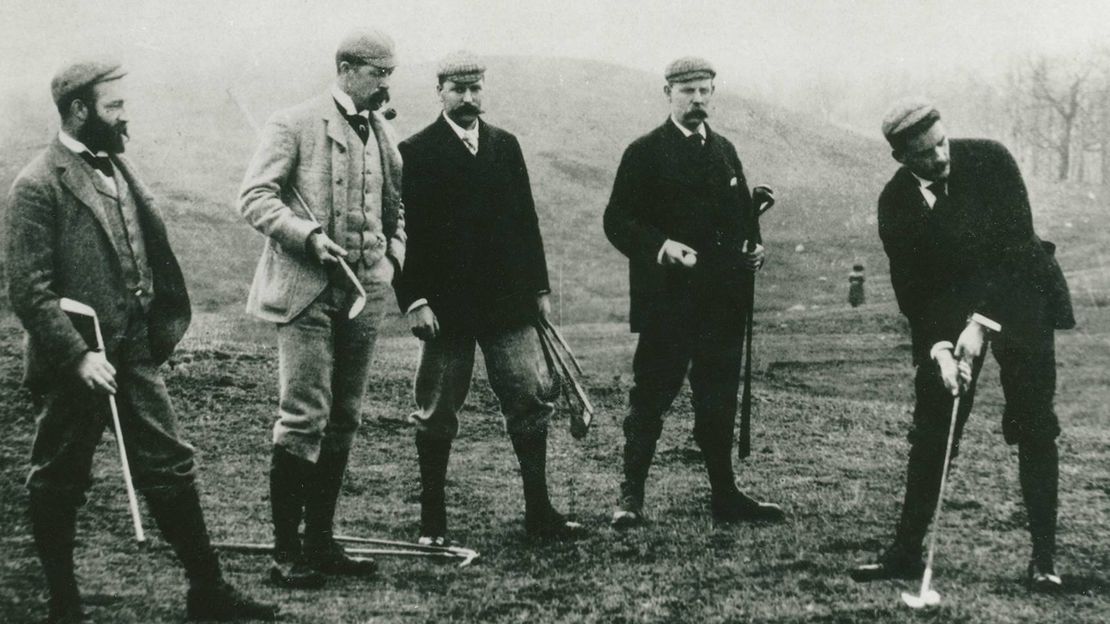
Why is Golf Still Seen as a Rich Person's sport? Unpacking the Myths and Realities
- Marcus Taylor
- Golf , Society
- June 6, 2024
Table of Contents
Introduction
Golf is known for its calm greens and precise play, but it’s also seen as a game for the wealthy. Ever wonder why golf has this ritzy rep? This vibe not only determines who feels comfortable swinging a club but also affects who actually gets to play.
In this article, we’ll explore why golf often feels more like a club for the rich and less like a sport for everyone. We’ll examine how history, money, and pop culture have given golf this elite label and discuss some cool efforts flipping the script to welcome everyone to the game.
Join us as we break down the barriers and celebrate the people working to make golf a game for all. Let’s get honest about changing the face of golf and making it fun and accessible for everyone, no matter their wallet size.
A Look Back: Golf’s Elite Origins
Golf’s fancy image didn’t just appear out of nowhere. It’s rooted in history, from its earliest days in Scotland several hundred years ago. Back then, golf was a pastime for royals and the upper class. This tradition crossed the ocean to America, becoming a status symbol among the wealthy. For those interested in a deeper dive into the sport’s rich history, you can read more about the history of golf here .
From Scotland to the States
When golf clubs started popping up in the USA, they were often built as exclusive venues where business and social elites gathered. These clubs weren’t just about the sport; they were a place to network and show off social status. Membership fees were steep, keeping the average Joe out and maintaining the sport’s high-society vibe.
Private Clubs and Public Perception
The tradition of private clubs and exclusive memberships reinforced the idea that golf was a luxury pastime. With most courses out of reach financially and physically for the general public, golf remained under the radar for many. It didn’t help that televised golf tournaments often featured affluent players and sponsors, making it seem like the game was still just for the well-to-do.
The Modern Impact
These historical roots have left a lasting imprint on golf’s image today. Even with more public courses and affordable options, the old perceptions are hard to shake off. Many young people still view golf as a sport for the old, rich, and connected rather than a fun and accessible activity.
Economic Barriers: The Myth of High Costs in Golf
While golf has a reputation for being a pricey sport, there are several ways to enjoy the game without breaking the bank. Dispelling the myth of high costs can help make the sport more accessible to a broader audience.
Affordable Equipment
Contrary to popular belief, starting in golf can be a manageable investment in brand-new equipment. Many golfers begin with used clubs, which can be found at affordable prices online or at second-hand sports stores. Additionally, renting clubs from golf courses is a budget-friendly option, often costing just a few dollars or euros. This allows newcomers to try the sport without committing to a large upfront purchase.
Reasonable Playing Options
Playing golf doesn’t always mean expensive green fees at elite clubs. Public golf courses, designed to be more inclusive and affordable, offer reasonable rates and are a great option for those on a budget. Moreover, many courses offer discounted rates during off-peak times or for younger players, making it easier for everyone to get into the game.
Coaching and Apparel
Finding a coach for golf can be as affordable as coaching for any other sport. Many coaches offer group sessions or beginner clinics at reduced rates, which can be a cost-effective way to improve your skills. As for attire, while some private clubs have strict dress codes, most public courses and practice ranges require only basic athletic wear. This means you can start playing in comfortable clothes you already own, without needing specialized golf apparel, further enhancing the sport’s accessibility.
Overcoming Economic Hurdles
By taking advantage of these cost-saving opportunities, golf becomes much more accessible. Communicating these options is important to dispel the notion that golf is only for the affluent. By highlighting the sport’s affordability and accessibility, we can open the sport to a wider, more diverse audience.
Cultural Perceptions: Golf’s Fancy Image
Let’s talk about why so many people see golf as a rich person’s game. Spoiler: it’s not just about the cost. Much of it concerns how golf is portrayed in the media and pop culture.
Media and Movies
Think about how golf is shown in movies and TV shows. It’s often in the context of fancy country clubs with members wearing designer clothes, sipping expensive drinks, and driving luxury cars. It’s all significantly “high society.” When did you last see a movie where someone played golf on a public course with an old set of clubs? Exactly.
For example, take the classic movie “Caddyshack” (1980). This comedy, set at an upscale country club, revolves around the antics of rich members and their caddies. While hilarious, it reinforces the idea that golf is tied to wealth and exclusivity. Then there’s “The Legend of Bagger Vance” (2000), which, although a bit newer, still depicts golf in a highly romanticized and elite light, with beautiful courses and well-dressed players.
Older films like “Pat and Mike” (1952), featuring Katharine Hepburn and Spencer Tracy, also showcase golf in a more exclusive setting. The characters are often seen playing at well-manicured courses that ooze sophistication and privilege. These portrayals make golf look like a sport for the well-to-do, cementing its ritzy reputation.
Pop Culture Vibes
This high-end image isn’t just in movies. Celebrities, business moguls, and even politicians are frequently seen playing golf. When you see famous people on the golf course, it’s easy to think that the sport is out of reach for regular folks. Social media also plays a big role in this. Instagram posts from stunning golf resorts or celebrity tournaments can make it seem like golf is only for those with deep pockets.
Think about it: Whenever a celebrity posts a picture from a gorgeous golf course, it gets thousands of likes and comments. They usually look effortlessly cool in their designer golf outfits at some exclusive club. These posts make golf seem like a glamorous, exclusive activity. When all you see is the glamorous side, it’s easy to forget that there are thousands of public courses where anyone can play without breaking the bank. And it’s not just social media. Music videos, TV shows, and even video games sometimes show golf as this elite, unattainable sport. Ever notice how golf is often depicted in luxury settings, with players using top-of-the-line gear? It’s all part of the vibe that makes golf seem more like a luxury pastime than a sport for everyone.
But let’s get real. While seeing your favourite celebs enjoying the game is excellent, you don’t need to be rich to play golf. Public courses are everywhere, and many of them are super affordable. Plus, the thrill of sinking a long putt or hitting an incredible drive is the same, no matter where you’re playing or what you’re wearing. So next time you see a flashy post or a TV show making golf look only for the elite, remember that the reality is way more inclusive. The golf community is diverse and welcoming, and the sport is way more accessible than it’s often portrayed. Whether at a local municipal course or a fancy country club, the essence of golf remains the same: the challenge, the fun, and the camaraderie.
The Dress Code Drama
Then there’s the whole dress code thing. Traditional golf attire can be pricey and feels exclusive. Those polo shirts, khakis, and golf shoes are costly, especially if you’re looking at brand-name stuff. This can make people think they need to spend a lot just to look the part, which adds to the perception that golf is a rich person’s sport.
Consider the unique styles of golfers like Tiger Woods, who rocks his Nike polos, or Rickie Fowler, known for his vibrant Puma gear. These players showcase their individuality through their fashion choices, challenging the notion that you need to conform to a specific golf attire to fit in on the course.
In movies, characters who play golf are usually decked out in top-notch attire. For example, in “Happy Gilmore” (1996), the contrast between Happy’s casual, somewhat sloppy attire and the pristine outfits of other golfers highlights how strongly the dress code is tied to the sport’s image. Similarly, in “Tin Cup” (1996), Kevin Costner’s character’s transition from a laid-back driving range pro to a severe golfer involves adopting more traditional golf attire.
Contrary to popular belief, many public courses have relaxed dress codes. You can sport your comfortable, everyday clothes like a nice T-shirt and shorts or casual pants, as long as you maintain a neat and respectful appearance. This means you don’t have to splurge on expensive golf attire to enjoy the game, making golf more accessible than you might think.
Breaking the Stereotype
But here’s the real deal: you don’t need to be rich to enjoy golf. There are plenty of public courses, and you don’t need designer gear to play. Wear what’s comfortable and respectful. Many courses are chill about the dress code if you look neat.
So, let’s ditch the stereotype. Golf is not for everyone. The fancy image is just that—an image. The real heart of golf is in the community, the challenge, and the fun of the game. And guess what? None of that requires a fat wallet.
Conclusion
The perception of golf as a sport exclusively for the wealthy is deeply rooted in its history, media portrayals, and cultural practices. However, this image only tells part of the story. While golf has traditionally been associated with luxury and exclusivity, the reality is that the sport is far more accessible than many realize.
Golf’s elite origins, steeped in history, have contributed to its high-society reputation. Yet, with affordable equipment, public courses, and relaxed dress codes, the sport is within reach for everyone, regardless of their financial status. Programs and initiatives are also actively working to make golf more inclusive, breaking down the barriers that have kept it out of reach for many.
Media and pop culture often reinforce the idea that golf is a luxury pastime, showing celebrities and wealthy individuals enjoying pristine courses in designer outfits. But everyday golfers know that the true essence of the sport lies in the camaraderie, the challenge, and the simple joy of play, which are accessible to all.
By challenging these stereotypes and highlighting golf’s affordability and inclusivity, we can open the doors to a more diverse and welcoming golf community. So, next time you think about golf, remember that it’s a game for everyone. Whether playing at a local public course or watching a major tournament, the spirit of golf is universal, and its joys are within reach for all.
Let’s continue to celebrate and promote a golf culture that values diversity and accessibility, ensuring that anyone who wants to pick up a club feels welcome on the green.


